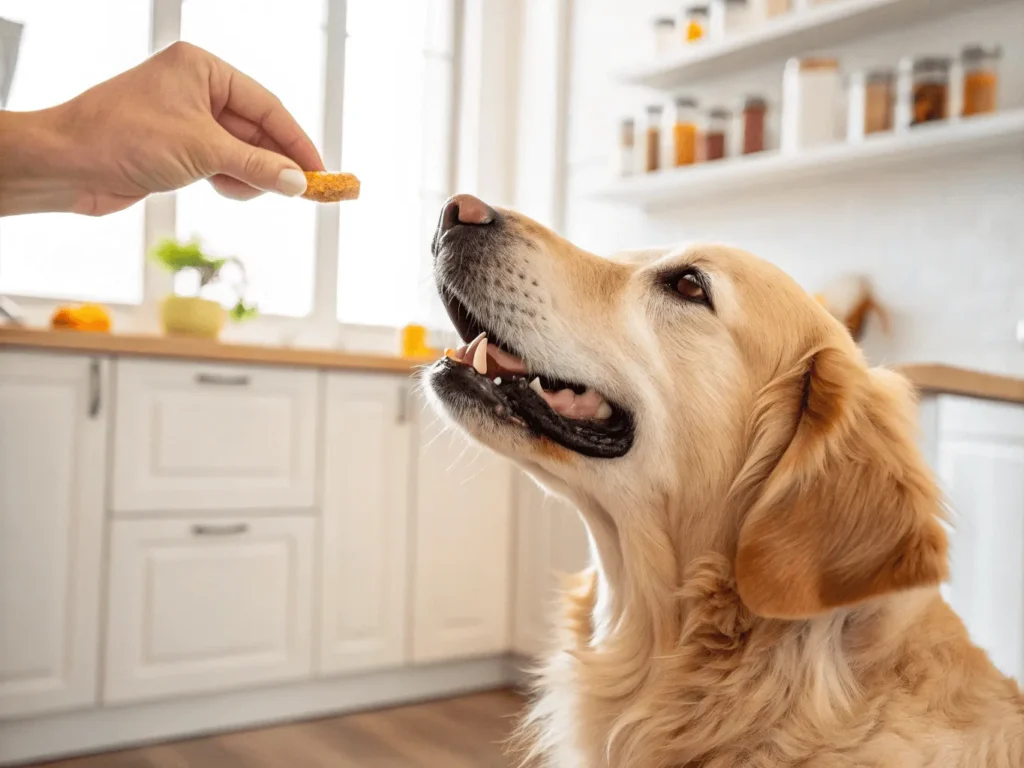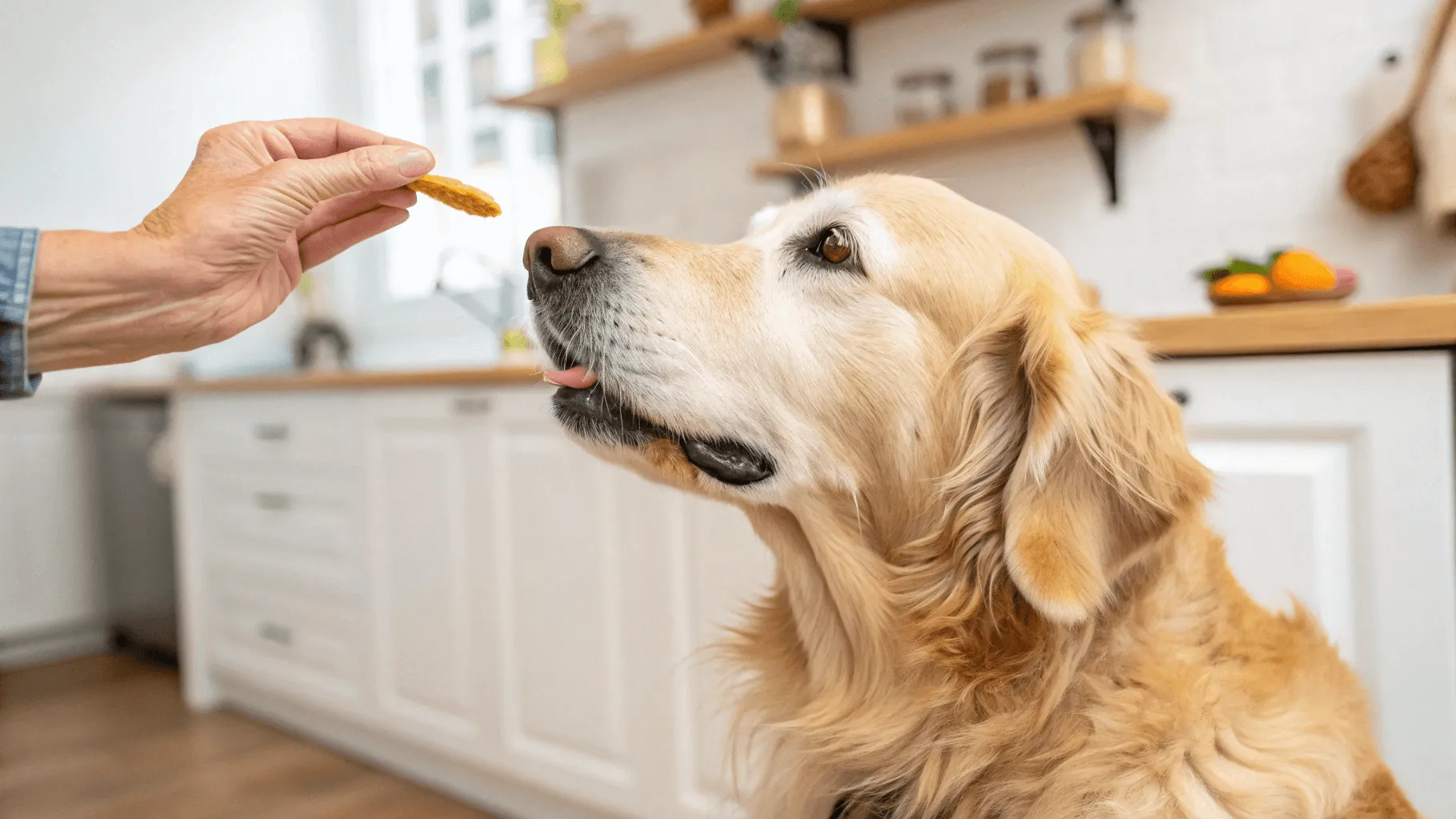Why Joint Health Matters for Dogs
If you’ve ever watched your dog struggle to get up after a nap or hesitate before jumping into the car, your heart probably sank a little. 😢 Our pups rely on strong hips and flexible joints to chase balls, climb stairs, and wiggle with joy when we walk through the door. But just like us, their joints can wear down with age, injury, or genetics — and that’s where the right dog hip and joint supplement can make all the difference.
Keeping your dog’s joints healthy isn’t just about comfort — it’s about quality of life. The earlier we support their mobility, the longer they can live pain-free, active, and full of tail wags. That’s where dog hip and joint supplements come in.
“Think of joint supplements as daily vitamins for your dog’s mobility — not just a fix, but a foundation.”
Signs Your Dog May Need a Joint Supplement

Dogs are stoic by nature — they don’t always show pain clearly. But there are some telltale signs that your pup might be dealing with joint stiffness or discomfort:
- 🐾 Slowing down on walks
- 🐾 Limping or favoring one leg
- 🐾 Trouble standing up or lying down — a common issue we also explore in our guide on how to help a dog with arthritis at home
- 🐾 Hesitation to jump on beds or into cars
- 🐾 Less interest in play or walks
- 🐾 Clicking sounds in the joints
Even subtle changes in behavior can signal that it’s time to take action. If your dog used to sprint to the door and now walks instead, their joints might be asking for help.
Breeds More Prone to Hip & Joint Issues
Some dog breeds are more likely to develop joint problems simply because of their genetics, size, or structure. Here are a few that tend to benefit most from early supplement support:
- Labrador Retrievers – Prone to hip and elbow dysplasia
- German Shepherds – Often develop hip issues early
- Golden Retrievers – At risk for arthritis and ligament injuries
- Dachshunds – Back and spine support is crucial
- Rottweilers & Mastiffs – Big bodies = big joint stress
- Border Collies & Australian Shepherds – High activity puts pressure on joints
That said, any dog can develop joint problems — especially as they age or after an injury.
How Dog Hip and Joint Supplements Work
Joint supplements support the cartilage, connective tissue, and fluid that cushion and lubricate your dog’s joints. Most of these formulas include a blend of anti-inflammatory ingredients, cartilage-building compounds, and joint-lubricating agents.
While they don’t work overnight, a dog hip and joint supplement builds up in your dog’s body over time — typically showing results within 4–8 weeks. When taken daily, they help reduce inflammation, restore joint comfort,and even slow the progression of conditions like osteoarthritis. According to the American Kennel Club (AKC), glucosamine and chondroitin are widely used and supported by veterinarians.
Think of it as giving your dog’s joints a “lotion from the inside” 🧴✨ — hydrating and protecting them from the wear and tear of daily movement.
Common Ingredients and Their Benefits
Here’s a breakdown of the most trusted ingredients found in quality hip and joint supplements:
- Glucosamine – Builds and repairs cartilage
- Chondroitin – Helps cartilage retain water and elasticity
- MSM (Methylsulfonylmethane) – Natural anti-inflammatory and antioxidant
- Hyaluronic Acid – Lubricates joints for smoother movement
- Green-Lipped Mussel – Rich in omega-3s and joint-soothing nutrients
- Turmeric/Curcumin – Reduces pain and inflammation naturally. You can also explore our post on natural anti-inflammatory foods for dogs to boost results through diet.
- Collagen – Supports tissue repair and flexibility
Each ingredient plays a role — and when combined, they can make a big difference in your pup’s mobility and mood 🐕💃.
“A good supplement doesn’t just help your dog move better — it helps them feel like themselves again.”
Top 5 Vet-Recommended Dog Hip and Joint Supplements

The pet supplement aisle can feel overwhelming — chews, powders, liquids… all promising to help. So which ones actually work?
Here are five types of dog hip and joint supplements that veterinarians often recommend and dog parents swear by:
1. Glucosamine & Chondroitin Blends
This is the gold standard — and for good reason. Glucosamine helps rebuild cartilage, while chondroitin improves its resilience and water retention. Together, they form the building blocks for healthy joints.
💡 Best for: Older dogs with arthritis, large breeds, or dogs recovering from orthopedic surgery.
Example brands: Dasuquin®, Cosequin®, VetriScience GlycoFlex
2. Green-Lipped Mussel-Based Supplements
This ocean-born superfood is packed with omega-3 fatty acids, antioxidants, and joint-protecting nutrients. It’s especially gentle on sensitive tummies and offers full-body anti-inflammatory effects.
💡 Best for: Dogs with allergies, sensitive digestion, or early joint discomfort.
Example brands: Super Snouts®, Natural Dog Company® Hip & Joint
3. MSM and Turmeric Options
MSM (a sulfur compound) and turmeric are both powerful natural anti-inflammatories. These ingredients help reduce pain and stiffness, especially in dogs with arthritis or age-related joint decline.
💡 Best for: Dogs who need fast pain relief with fewer side effects than NSAIDs.
Example brands: Zesty Paws®, PetHonesty®, Vet’s Best
4. Collagen and Hyaluronic Acid Boosters
These ingredients are gaining popularity for their role in lubricating joints and supporting soft tissues like tendons and ligaments. Collagen also strengthens nails, skin, and coat — a great bonus!
💡 Best for: Active dogs, agility competitors, and dogs recovering from injuries.
Example brands: Native Pet, The Missing Link, Canine Matrix
5. Chewables vs. Liquid vs. Powder – Which Is Best?
- 🦴 Chewables: Easiest to give, often flavored, perfect for picky pups
- 💧 Liquid: Fast-absorbing, great for dogs with dental issues
- 🥄 Powder: Ideal for mixing into meals or homemade treats
There’s no one-size-fits-all — choose the format your dog accepts best and that fits your daily routine.
How to Choose the Right Supplement for Your Dog
Picking the right dog hip and joint supplement is a bit like choosing shoes — it depends on size, age, activity level, and specific needs. Here’s how to narrow it down:
Factors to Consider: Age, Size, Activity Level
- Puppies & young adults: Choose preventative formulas with glucosamine and omega-3s
- Seniors: Look for high-potency blends with anti-inflammatories like MSM and turmeric
- Large breeds: Opt for higher dosages tailored for big bodies
- Athletes or working dogs: Choose recovery-focused ingredients like collagen or green-lipped mussel
“Your dog’s lifestyle should guide their supplement — just like our own diets change over time.”
Reading Labels: What to Look For (and Avoid)
✅ Look for:
- Clearly listed active ingredients and dosages
- Veterinarian approval or clinical testing
- No artificial colors or preservatives
- USA-made or trusted manufacturing standards
🚫 Avoid:
- “Proprietary blends” with no dosage transparency
- Overpromises like “cure for arthritis”
- Sugar-filled chews that spike calories
When in doubt, ask your vet to review the label with you — especially if your dog is on medications or has allergies.
How to Introduce Joint Supplements to Your Dog
You’ve picked the right supplement — now what? Start slow, go steady, and pay attention to how your pup responds.
Dosage Tips and Transition Plans
- Start with half the recommended dose for the first 3–5 days to avoid tummy upset
- Slowly increase to full dose based on your dog’s weight and needs
- Stick to a consistent daily schedule (breakfast time is perfect!)
📌 Pro Tip: Track changes in your dog’s mobility, mood, and activity level each week — even subtle improvements matter. For step-by-step help with fussy eaters, check out how to give your dog pills without a struggle.
Mixing Supplements with Meals: Tricks for Picky Eaters
Some dogs treat supplements like buried treasure — they sniff them out and spit them right back at you. 😅
Here are a few tricks that work:
- Hide chews in peanut butter or wet food
- Mix powder into bone broth or goat milk
- Use a soft treat as a “pill pocket”
- Offer the supplement before mealtime when your dog is hungrier
If all else fails, try a flavor-switch — some dogs prefer fish over chicken, or vice versa.
“The best supplement is the one your dog will actually eat — don’t be afraid to experiment.”
Do Supplements Really Work? What Science and Pet Parents Say
If you’re wondering whether joint supplements are worth it, you’re not alone. Many dog parents ask: “Are these really helping my dog, or is it just wishful thinking?”
Here’s the truth: Joint supplements aren’t magic pills, but when used consistently, they can significantly improve comfort, mobility, and mood — especially when combined with lifestyle support.
Clinical Studies vs. Real-Life Results
Scientific studies back the benefits of glucosamine, chondroitin, MSM, and omega-3s — particularly for dogs with early arthritis or post-surgery recovery.
But real-world results are often more powerful than research papers:
“After 3 weeks on a dog hip and joint supplement, my 10-year-old Lab started trotting on walks again. I hadn’t seen that spark in months.” — Katie, Colorado
What you’ll likely see:
- More willingness to play and walk
- Easier time getting up or down stairs
- Less limping or stiffness after rest
- A brighter, more energetic attitude
Common Myths About Dog Joint Supplements
Let’s bust a few common misconceptions:
❌ Myth: “Supplements are only for senior dogs.”
✅ Truth: Dogs of all ages — especially large or active breeds — benefit from joint support early.
❌ Myth: “If it doesn’t work in a week, it’s useless.”
✅ Truth: Most supplements take 4–8 weeks to build up and show results.
❌ Myth: “Natural means it’s always safe.”
✅ Truth: Even natural ingredients can interact with meds or cause side effects. Always check with your vet.
Natural Ways to Support Hip and Joint Health Alongside Supplements
Supplements work best when they’re part of a whole-dog approach. Think of them as your foundation — and these extras as supportive beams:
Weight Management and Diet Support
Every extra pound adds pressure to your dog’s joints. Keeping your pup at a healthy weight is the single most important thing you can do.
- Switch to joint-support kibble with added glucosamine
- Try a raw or gently cooked diet rich in anti-inflammatory ingredients
- Add fresh foods like salmon, blueberries, or turmeric (with your vet’s approval!)
Low-Impact Exercise Ideas for Stiff Dogs
Motion is lotion for the joints! Gentle, regular movement helps prevent stiffness.
🐾 Great activities include:
- Swimming (zero impact, full range of motion) — it’s one of the exercises we highlight in our joint-friendly activities for senior dogs guide.
- Slow leash walks on soft terrain
- Doggy yoga or massage therapy
- Canine physical therapy (yes, it’s a thing!)
Avoid high-impact actions like jumping off furniture, running on concrete, or chasing hard balls.
“Think daily movement, not intense workouts — consistency beats intensity every time.”
Safety, Side Effects, and When to Talk to Your Vet
Joint supplements are generally safe — but not risk-free. Here’s what to watch for:
Potential Reactions and What to Watch For
🚩 Contact your vet if your dog experiences:
- Vomiting or diarrhea
- Loss of appetite
- Allergic reactions (itching, swelling, rash)
- Fatigue or mood changes
These are rare, but always start new supplements under your vet’s guidance — especially if your dog takes other medications.
Supplements vs. Surgery: When Is It Time?
Supplements are excellent for prevention and early intervention, but they can’t reverse severe joint damage.
Talk to your vet about surgical options if:
- Your dog’s pain is affecting daily life
- They’ve lost mobility despite all efforts
- There’s a diagnosed condition like hip dysplasia or a torn ligament
Combining both approaches can often lead to the best outcome.
Real Stories: How Supplements Helped Our Dogs Thrive 🐶💕

Case Study: Senior Labrador with Arthritis
Bella, a 12-year-old yellow Lab, struggled with standing up and no longer played with her grandkids.
Her parents added a chewable glucosamine supplement, omega-3s, and started her on short daily walks. Within six weeks, she was more playful, and even wagging at the door again for walks. 💛
“We didn’t expect a miracle — but we got our sweet girl back.” — Lisa, Ohio
Case Study: Young German Shepherd with Early Hip Dysplasia
Ryder, a 2-year-old shepherd, was diagnosed with mild hip dysplasia. Instead of jumping straight to surgery, his vet recommended joint supplements, weight control, and physical therapy.
Now, Ryder hikes weekly and shows no signs of pain — just a big goofy grin and endless energy 🐕🌲
FAQs About Dog Hip and Joint Supplements
How long does it take for supplements to work?
Most dogs show improvement in 4 to 8 weeks with daily use. Be patient and consistent — results build over time.
Can I give human supplements to my dog?
Not safely. Human supplements often contain xylitol, sweeteners, or dosages unsafe for pets. Stick to vet-approved dog formulas.
Are joint supplements safe for puppies?
Yes — but only puppy-formulated or vet-approved ones. Large breed puppies especially benefit from early joint support, but dosage and timing must be tailored carefully.
Final Woof: Helping Your Dog Stay Active and Pain-Free 🐾
Watching your dog struggle with stiff joints is heartbreaking — but it’s not the end of their joyful days.
With the right dog hip and joint supplement, a bit of patience, and loving daily care, you can help your best friend run, play, and stretch out in the sun again — tail wagging, head high.
“They gave us their whole heart — let’s give them back the freedom to move without pain.”

